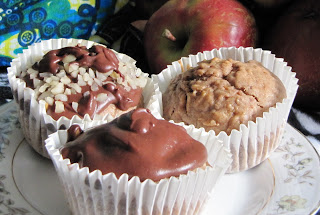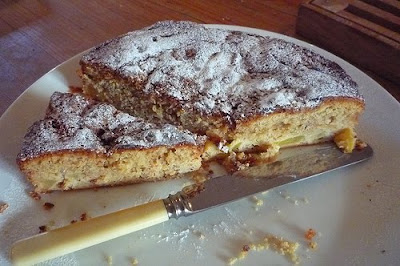
Friday, 4 February 2011
Tree (cake) Revolution

Friday, 8 October 2010
Autumnal Apple Cupcakes

With the change in seasons, there are hundreds of fallen apples on the ground around Bristol. Just outside our office in fact, we have a small public open space that is planted with cherry and apple trees. In the spring the trees were laden with blossom. The birds were first to the cherries, but luckily they have not been so interested in the apples. Inspired by the abundance of fruit, we’d like to share with you our recipe for 12 cupcakes.
Ingredients
½ tsp apple cider vinegar
150ml soya milk
100ml maple syrup
75ml vegetable oil
200g plain flour
1 teaspoon ground cinnamon
¾ tsp baking powder
½ tsp bicarbonate of soda
¼ tsp salt
200g grated apple
Topping (for extra tree ingredient points)
chopped mixed nuts (almonds and walnuts)
50g chocolate chips
3tbsp soya cream
Directions
- Preheat oven to 175 deg C. Line muffin tray with paper cases.
- Mix the soya milk and apple cider vinegar in a large bowl; allow to sit for a few minutes to separate.
- Beat in the maple syrup and oil.
- Sift in the flour, baking power, bicarbonate of soda and salt. Mix until smooth and then stir in the apple
- Fill the cases about two-thirds full.
- Bake for 20 to 25 minutes, remove from oven and place cakes on wire rack to cool.
For the ganache topping
- Gently heat the soya cream to near boiling.
- Remove from the heat and stir in the chocolate chips.
- Leave for 10 minutes to cool then decorate the cooled cupcakes.
- Sprinkle with chopped nuts (optional).
Tree ingredients: apple, maple, cinnamon, chocolate, almonds and walnuts
We’d love to try your favourite tree cake recipe, please email it to info@treeaid.org.uk
Please do remember to check with landowners before foraging for fruit and nuts!
Monday, 19 July 2010
Apple and Hazelnut Cake

Hazelnut trees are very common in the UK, however you'll be hardpressed to get your hands on any before the squirrals do! But maybe you'll be lucky enough to forage your own hazelnuts, if not I have had more success foraging for apples, once you know where a good tree is you can go back until the seasons over.
There are 4 tree ingredients in this recipe, Hazelnuts, Apples, Lemon and Cinnamon. I would like to thank London Liberty Girl for the use of this recipe.
Ingredients
450g apples you can use cookers such as Bramleys or any eaters
Juice of half a lemon
225g butter
175g caster sugar
50g soft brown sugar
1 tsp vanilla essence — do not substitute flavouring. Better to use nothing.
3 eggs
225g self-raising flour
2 tsp baking powder
1 tsp cinnamon
30g ground hazelnuts
Directions
- Preheat oven to 180°C or 350F, gas mark 4
- Grease 8inch cake tin.
- Peel, core & chop the apples into small chunks. To stop them going brown, squeeze the lemon juice over.
- Put the butter and both sugars into the mixing bowl, and cream together. You are aiming for a light & fluffy start to the process.
- Add the vanilla essence, and then one egg at a time, along with a spoonful of flour, to avoid the mixture curdling.
- Then add the rest of the flour a heaping spoonful at a time, followed by the rest of the dry ingredients: cinnamon, ground hazelnuts & baking powder
- Add the apple pieces to the mix. Fold them all together. Don’t worry if the mixture is stiffer than you would want in normal cake. You need it like that as the apples will leach their juice during baking. Mix really well so the apple is distributed throughout the cake batter.
- Pour the mixture into the lined cake tin
- Pop in oven for 45 minutes. You may find that the top browns very quickly, so try adding a piece of paper over the top of the cake at this point and then cook for a further 15 minutes for an hour total.
- Test the cake for done-ness at 45 minutes with a skewer. If the cake is cooked, the skewer will come out clean. Test in several places around the centre of the cake because if you hit a piece of apple the skewer will come out pretty clean giving a false positive so to speak. If there is any hint of batter on the skewer it needs more cooking.
- When you think the cake is done, remove the tin from the oven, leave on an airing rack to cool.
- Sift icing sugar over the top to finish and enjoy eating.
Friday, 25 June 2010
Guava Cake

Guava Psidium guajeva is a small tree native to Mexico, Central America and northern Southern America, but are now grown throughout the tropics and in some subtropical regions too. The fruits have high vitamin A and C content and have a high quantity of pectin, this means they are particularly good for making jams and preserves. Guava paste is like a thick jam but with less added sugar and a great ingredient for cooking and baking.
Guava is one of the trees that are being planted through TREE AIDs work. In Northern Ghana, the community Nurseries and Woodlots Project in Kandema enables the local community to grow trees such as guava to help reduce deforestation. This is done by giving people the skills to grow the trees from seed in nursuries and then transplant them into woodlots, the species grown include Guava, Cashew and Mango. Guavas provide fruit for food and sale and wood for fuel and encouraging these trees to be cultivated sustainably improves the soils fertility.
Here is a recipe for you that contains guava paste, you can use guava jam but if you do this then use less sugar than the recipe tells you, otherwise it'll be too sweet! You should be able to get hold of Guava paste from any health food shop or international market, but I'm not sure if your average supermarket will stock it.
Tree Ingredients include Guava. This recipe was kindly donated by, CDKitchen.
Ingredients
170 g butter
230g sugar
460g flour
2 eggs
1 teaspoon baking powder
1/4 teaspoon salt
1 teaspoon vanilla extract
280g guava paste
Directions
- Preheat oven to 180 C, 350 F or gas mark 4.
- Cream butter. Add sugar little by little.
- Add eggs one by one, followed by vanilla.
- Sift flour together with baking soda and salt. Mix with the sugar/egg mixture.
- Pour half the batter in a greased square (8x8) cake pan. Cut the guava paste in slices and use the slices to cover all the batter. Pour the rest of the batter on top of the guava slices.
- Place in oven and bake for 45-60 minutes. Check cake for doneness (an inserted toothpick comes out clean) as oven temperatures varies.
Friday, 18 June 2010
We want your recipes...
In the TREE AID office the fundraising team have a book club every fortnight. The team comes together to read about fundraising and to discuss and reflect on the fundraising initiatives and techniques used within the charity. As part of this a member of the team volunteers to bake a cake using tree ingredients. So send us your recipes and we'll have a go at baking them and I'll let everyone know how its going on the blog.
I only volunteer in the office one day a week, so will only receive your emails and recipes then, but I am very much looking forward to seeing what scrumptious cakes your going to suggest!
Please send your recipes to treeaidvolunteer@treeaid.org.uk
Friday, 4 June 2010
Bees and Trees: A Honey Cake

As part of TREE AIDS work there are projects that focus on bee keeping and the planting of malliferous (honey producing) trees. In Burkina Faso as part of TREE AIDS work people are also tought how to build bee hives as well planting trees that are particularly good for bees, one of these being the Mango Tree. Projects like this one are really helpful in a number of ways, they are beneficial for the regeneration of land and increase biodiversity through the tree planting. Honey production also helps to create sustainable income generation for communities and honey becomes available for domestic use too.

Here's a recipe for you to try that is from a website called CDKitchen and looks absolutely delicious! Tree Ingredients include Cinnamon which comes from the bark of a tree, Cloves, Coffee and indirectly Honey.
Ingredients
560g cups all-purpose flour
2 teaspoons baking powder
2 teaspoons cinnamon
1/2 teaspoon baking soda
1/2 teaspoon salt
1/2 teaspoon ground cloves
3 large eggs
230ml or 225g honey
230g sugar
230ml vegetable oil
120ml cup brewed coffee
60ml cup water
Directions
- Preheat oven to 350 F, gas mark 4 and generously grease pan.
- Into a large bowl sift together flour, baking powder, cinnamon, baking soda, salt, and cloves.
- In a small bowl lightly beat eggs. Make a well in center of flour mixture and add eggs with remaining ingredients, whisking until combined well.
- Pour batter into pan and bake for about 50 minutes or until a skewer comes out clean.
- Leave to cool on a wire rack.
Friday, 23 April 2010
Lemon Drizzle Cake

Lemons are our one tree ingredient in this recipe. The lemon tree is an evergreen tree, originally native to Asia, although now more associated with Mediterranean countries.
Ingredients
125 gm Butter
175 gm Caster Sugar
2 large Eggs
175 gm Self-raising flour
50 gm Granulated Sugar
2 preferably unwaxed Lemons
Directions
- Preheat the oven to 180 degree.
- Lightly oil and line the base of an 18 cm/7 inch square cake tin with baking paper.
- In a large bowl, cream the butter and sugar together until soft and fluffy. Beat the eggs, then gradually add a little of the egg to the creamed mixture, adding 1 tablespoon of flour after each addition.
- Finely grate the rind from one of the lemons and stir into the creamed mixture, beating well until smooth. Squeeze the juice from the lemon, strain, then stir into the mixture.
- Spoon into the prepared tin, level the surface and bake in the preheated oven for 25-30 minutes.
- Mix the zest of the last lemon with 25 gm of the granulated sugar and reserve.
- Squeeze the juice of that lemon into a saucepan. Add the rest of the granulated sugar to the lemon juice and heat gently, stirring occasionally. When the sugar has dissolved simmer gently for 3-4 minutes until syrupy.
- With a fine skewer prick the cake all over. Sprinkle the lemon zest and sugar over the top of the cake, drizzle over the syrup and leave to cool in the tin.
- Cut the cake into squares and serve.
